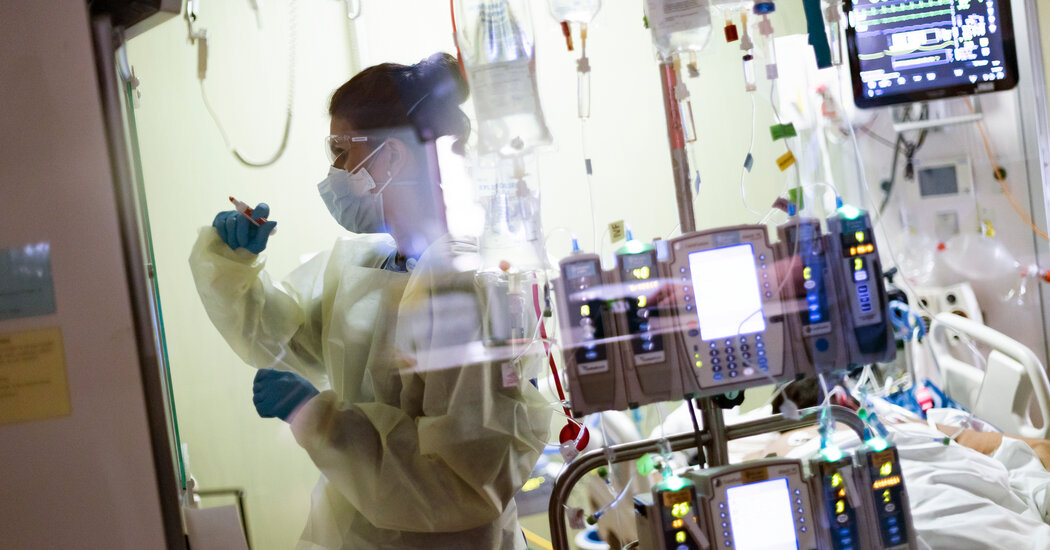
Oregon and Idaho Are Running Out of I.C.U. Beds as Covid Cases Hit Records

Daily Covid Briefing
Sept. 6, 2021, 9:45 a.m. ET
Sept. 6, 2021, 9:45 a.m. ET

Oregon and Idaho have joined the list of U.S. states that are running out of I.C.U. beds as both confront a dramatic rise in new coronavirus infections.
The Oregon Health Authority reported on Saturday that only 50 of the state’s 638 hospital beds were still available. Gov. Brad Little of Idaho, a Republican, said in a statement last week that just four of the state’s nearly 400 beds were still open.
The national Delta-driven surge has filled hospitals in many states. Only a handful have more than 30 percent of their overall I.C.U. beds still available, according to data from the Department of Health and Human Services, and many have less.
Mr. Little and Gov. Kate Brown of Oregon, a Democrat, each mobilized members of their state’s National Guard last month to add extra hospital staff.
“We are dangerously close to activating statewide crisis standards of care,” Mr. Little said in his statement. “In essence, someone would have to decide who can be treated and who cannot.”
Mr. Little’s state is grappling with its highest surge in Covid-19 hospitalizations to date. Idaho had a seven-day average of 512 hospitalizations on Friday, a number that has grown rapidly since July, according to a New York Times database.
In Oregon, the seven-day average of hospitalizations hit 1,219 on Friday, almost double the previous high reached in December.
The dire numbers don’t do justice to the mounting crisis that is overwhelming hospitals and health care workers in both states, officials said. Mr. Little said that even as hospitals made room for extra I.C.U. beds, they filled up — fast.
Demand for beds in Oregon is also exceeding supply. Patrick Allen, the director of the Oregon Health Authority, said in an interview on Saturday that 127 patients in the state were waiting in emergency departments for beds to open up. He said hospitals in southern Oregon, where vaccination rates were lowest, were especially hard hit.
“We’re on the edge of what we can manage right now,” he said, looking ahead to next week, when children would be returning to school in the most populous parts of the state. “There is not much room for things to get a lot worse.”

New Zealand announced on Monday that it will ease Covid-19 restrictions outside its largest city, Auckland, ending a series of lockdowns that began in August.
Residents outside Auckland will be allowed to return to work and school, and the nationwide alert level will be lowered to Level 2 starting Wednesday morning, Prime Minister Jacinda Ardern said at a news conference. Auckland, a city of almost 1.7 million, will remain at Level 4, which means that everyone but essential workers must remain at home. Schools will reopen on Thursday morning, she said.
New Zealand is one of the last countries pursuing a so-called Covid zero strategy, enforcing severe restrictions on movement and activities until there are no new cases.
Other governments that have employed this strategy, including Hong Kong and Singapore, have recently said that they may start loosening those measures, as fatigue among citizens grows and because of the threat to economic growth.
Because of the severity of restrictions put in place in August, the average number of daily new cases remains relatively low, at 36. The nation’s vaccination campaign has gotten off to a sluggish start, with only 49 percent of the population having received at least one dose, below the 62 percent in the United States and 72 percent in Britain.

A World Cup qualification game between Brazil and Argentina, South America’s most successful soccer teams, was halted after only a few minutes on Sunday after Brazilian health authorities walked onto the field in an apparent dispute about coronavirus quarantine regulations.
In chaotic scenes in São Paulo, Brazilian public health officials entered the field minutes into the highly anticipated showdown and ordered Argentina’s players off the field. Officials from both sides, a small crowd allowed inside the stadium and a global television audience struggled to comprehend what was taking place.
At issue was the status of four members of Argentina’s roster, including three starters who play club soccer in England’s Premier League. According to local regulations, foreign travelers who had spent time in Britain in the previous 14 days are required to quarantine upon arrival in Brazil.
Argentina arrived with four England-based players and started three on Sunday. All of the players had first traveled to Venezuela, where Argentina played a qualification game last week, before arriving in Brazil three days ago.
In images beamed live around the world, health officials and some of the Argentina players were involved in a brief altercation before the visiting team returned to its locker room. The on-field discussions involved officials from both teams and stars like Lionel Messi and Neymar.
The match’s referee eventually suspended the game. Once Argentina retreated to its locker room, Brazil’s players waited on the field before beginning a training session using half of the field to entertain the stunned crowd. Meanwhile, a police motorcade prepared to take Argentina’s players away from the stadium.
The events threaten to further damage relations between FIFA, soccer’s governing body and the organization responsible for the World Cup, and Europe’s top clubs and leagues, which have been embroiled in a dispute over the release of players for the qualification games.

A summer that began with plunging caseloads in the United States and real hope that the worst of Covid-19 had passed is ending with soaring death counts, full hospitals and a bitter realization that the coronavirus is going to remain a fact of American life for the foreseeable future.
Vaccination rates are ticking upward, and reports of new infections are starting to fall in some hard-hit Southern states. But Labor Day weekend bears little resemblance to Memorial Day, when the country was averaging fewer than 25,000 cases daily, or to the Fourth of July, when President Biden spoke about nearing independence from the virus.
Instead, with more than 160,000 new cases a day and about 100,000 Covid patients hospitalized nationwide, this holiday feels more like a flashback to 2020.
In Kansas, many state employees were sent home to work remotely again. In Arizona, where school mask mandates are banned, thousands of students and teachers have had to go into quarantine. In Hawaii, the governor has issued a plea to tourists: Don’t visit.
“The irony is that things got so good in May and most of June that all of us, including me, were talking about the end game,” said Dr. John Swartzberg, an infectious disease specialist at the University of California, Berkeley. “We started to enjoy life again. Within a very few weeks, it all came crashing down.”
The resurgence has left the country exhausted, nervous and less certain than ever about when normalcy might return.
More than 1,500 Americans are dying most days, worse than when cases surged last summer but far lower than the winter peak. Though the rate of case growth nationally has slowed in recent days and incremental progress has been made in Southern states, other regions are in the midst of growing outbreaks.
Vaccines are effective in preventing severe disease and death, but 47 percent of Americans are not fully vaccinated, allowing the highly infectious Delta variant more than enough opportunity to inflict suffering and disrupt daily life. Health officials say that most of the patients who are being hospitalized and dying are not vaccinated, and that it is those unvaccinated people who are driving the current surge and burdening the health care system.

The Biden administration will only offer Covid-19 booster shots once federal health regulators offer their support, the White House chief of staff said on Sunday, reiterating a pledge from administration officials.
“I want to be absolutely clear,” Ron Klain, the chief of staff, said on CNN’s “State of the Union” news program. “No one’s going to get boosters until the F.D.A. says they’re approved, until the C.D.C. advisory committee makes a recommendation.”
The pledge followed a report on Friday by The New York Times that top federal health officials had told the White House to scale back the planned booster campaign, arguing that regulators needed more time to collect and review all the necessary data.
In August, the Biden administration announced a plan to start offering boosters the week of Sept. 20 to adults who had received their second shot of the Pfizer-BioNTech or Moderna vaccine at least eight months earlier. In making the announcement, the administration said the plan was contingent on clearance from the Food and Drug Administration and recommendations from a Centers for Disease Control and Prevention advisory committee.
Some health experts have argued that before starting a booster program, the administration should push first to reach more unvaccinated Americans who have been stricken hardest by the highly contagious Delta variant in both hospitalizations and deaths.
Regulators are just beginning to review critical data that will help them determine how to proceed on the issue of boosters. Pfizer finished its booster application to the F.D.A. less than two weeks ago, and Moderna said on Friday that it had just completed its own.
Dr. Anthony S. Fauci, the director of the National Institute of Allergy and Infectious Diseases, said on the CBS news program “Face the Nation” on Sunday that it was possible that only the Pfizer-BioNTech booster would be approved by Sept. 20. But he said that any delay in clearing the Moderna booster would be only a few weeks at most.
The F.D.A. has already authorized a third dose of the Pfizer and Moderna vaccines for people who are immuno-compromised.
Source: https://www.nytimes.com/live/2021/09/06/world/covid-delta-variant-vaccine/


















